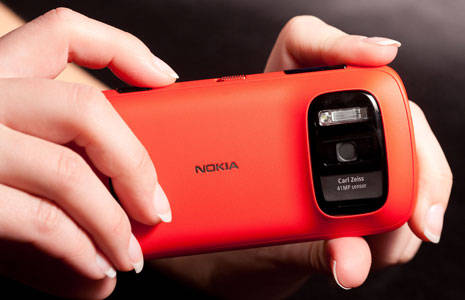MWC 2012: Nokia's surprising 41MP Symbian phone

Nokia has unveiled a surprisingly powerful multimedia cameraphone at this week's Mobile World Congress in Barcelona. Nokia says the PureView 808 can shoot full 1080p HD video with auto focusing at 30fps, and "capture stereo CD-like audio quality". Not only does the phone claim a resolution of 41 megapixels, it also runs the Belle (Symbian) smartphone operating system, which originated in the UK with Psion. Nobody predicted that would steal the show.
Nokia says the PureView 808 has a 41MP sensor with a resolution of 7728 by 5368 pixels, though it will be 38MP (7152 x 5368 pixels) in 4:3 mode, like a TV picture, or 34MP (7728 x 4354) in 16:9 widescreen mode. This would produce rather large image files, so the default setting for stills is 5MP in 16:9 mode, though you can increase this to 8MP. These settings allow for oversampling (using multiple pixels to create one pixel) or in-camera zooming (discarding pixels outside the desired frame). In other words, when you zoom with the PureView 808, you're just selecting a subset of the total sensor area.
Oversampling is good because it means you can eliminate the sort of noise that affects the low light performance of cameraphones and cheap compact cameras.
Update: You can also take photos in "full resolution" mode, which means 38MP in 4:3 mode or 34MP in widescreen mode, as mentioned above. The former uses the maximum height of the circular sensor, while the latter uses the maximum width. Nokia has posted "some unretouched photographs straight from the Nokia 808 PureView", with three images making up a 31.8MB download. (The 41MP is derived from multiplying the maximum height by the maximum depth, but doesn't exist in real life: the corners would be vignetted.)

Of course, many people have learned through the "megapixel wars" in the digital camera business that the pixel count is not necessarily a good guide to picture quality. The physical size of the sensor makes a huge difference, as do the quality of the lens, the overall construction quality, and the hardware and software used to processes the raw sensor data.
Nokia has been paying attention. It's using a 5-element Carl Zeiss lens in a high-precision camera construction, and has added a "special companion processor" to do pixel scaling because of the high volume of pixels involved -- over a billion a second with video.
Nokia is also using a 1/1.2" sensor, which it says is "approximately 2.5 larger" than the sensor used in the 12MP Nokia N8. Since this was very good for its day, it's reasonable to assume that the PureView 808 will do better.
And while it doesn't mean photographers are going to stop using real cameras, it does mean PureView 808 users should get better pictures when they don't have a real camera handy.
For those familiar with 35mm photography, the PureView 808 has a 24mm wide angle lens -- equivalent to 26m (16:9) or 28mm (4:3) -- and an aperture of f/2.4. It can focus down to 15cm.
For smartphone buffs, the PureView 808 has a 4-inch AMOLED screen with Gorilla Glass, a 1.3GHz processor running Nokia Belle Feature Pack 1, 16GB of built-in storage, and a microSD expansion slot that can handle 32GB cards. Weight including battery is 169g, and talk time is 6.5 hours.
Symbian was the "burning platform" Nokia wanted to leave behind, though it would probably have been better off if that idea hadn't emerged via a leaked memo. The PureView 808 won't change that, but it looks like a good upgrade for E7 and N8 users. It could also find buyers among those who want a particularly good camera, assuming real-life performance lives up to theory.
And since it's a Nokia, I expect it will actually make decent voice calls, unlike many of the smartphones on the market.